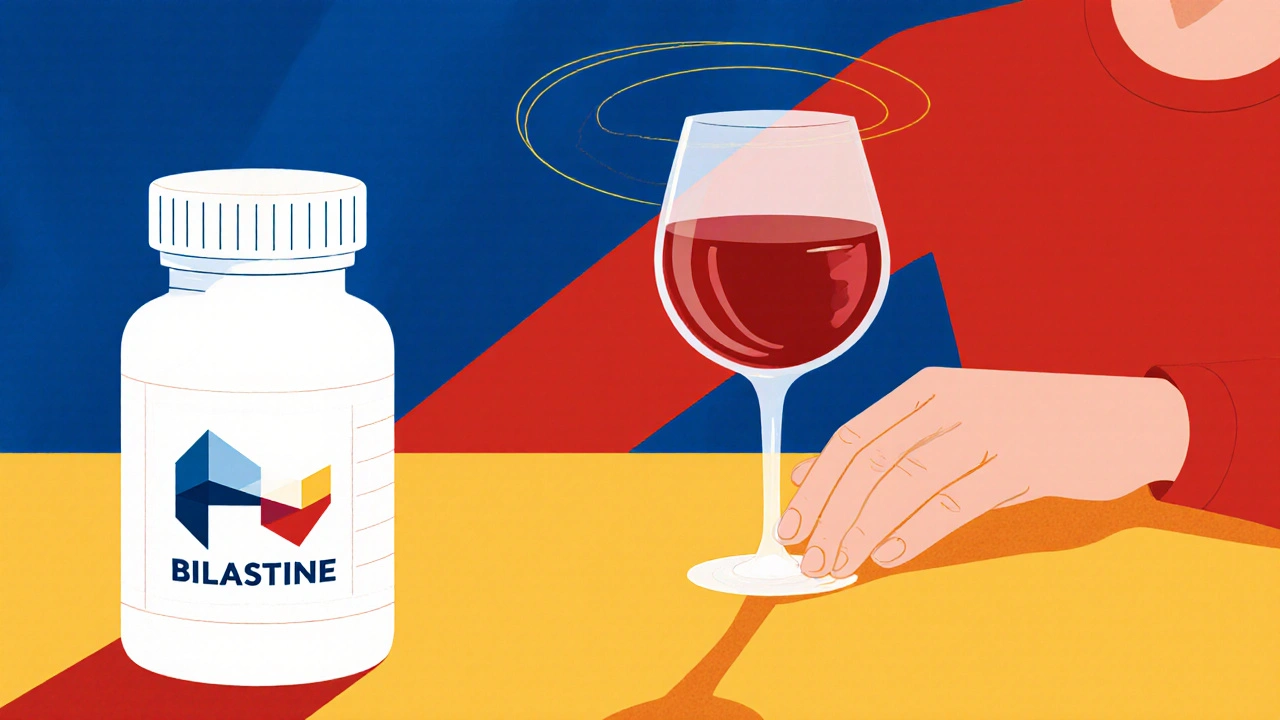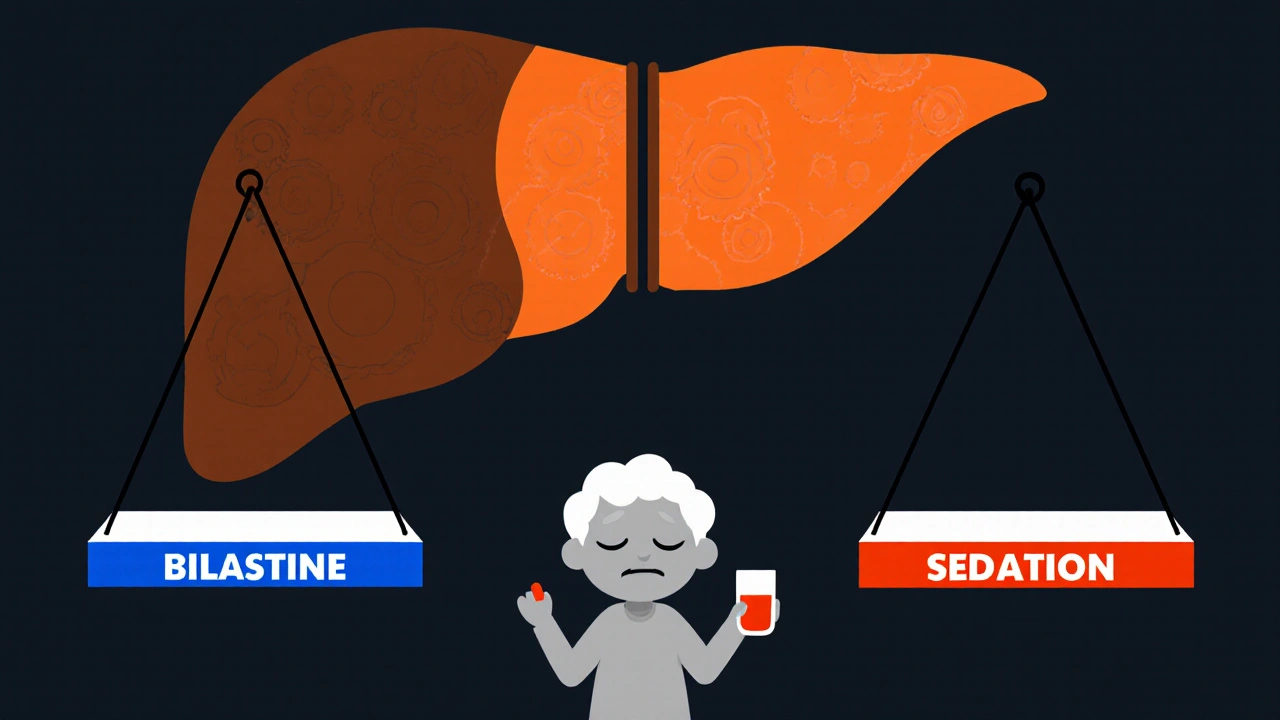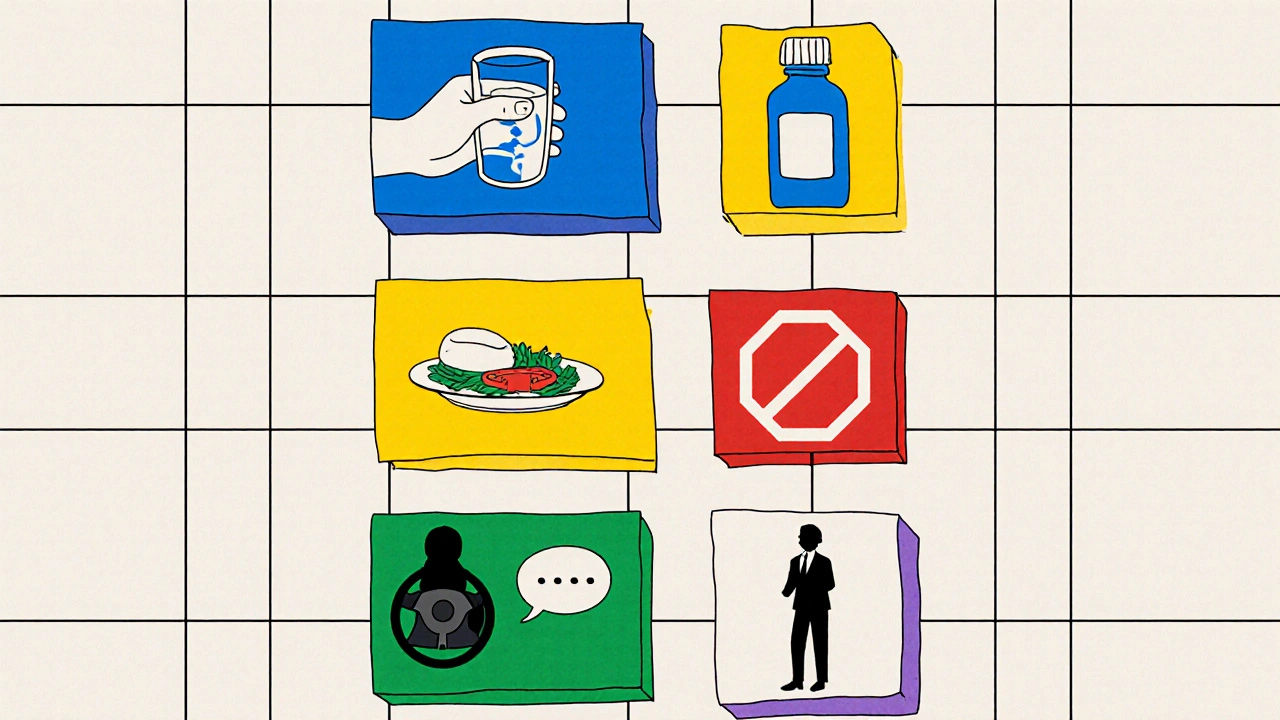Bilastine and Alcohol Interaction: Safety Tips & Risks

Bilastine & Alcohol Risk Calculator
How This Tool Works
This calculator assesses your risk level when taking bilastine and drinking alcohol. Based on your inputs, it will show whether you should proceed with caution or avoid alcohol completely.
When you reach for a drink after a long day, you might also be taking a pill for allergy relief. Mixing those two seems harmless, but the combo of Bilastine is a second‑generation antihistamine used to treat allergic rhinitis and chronic urticaria and alcohol can throw off your body in ways you don’t expect. Below you’ll find the key facts you need to decide whether a cocktail is worth the risk.
Quick Takeaways
- Bilastine is not metabolized by the liver’s CYP450 enzymes, so classic drug‑enzyme interactions are rare.
- Alcohol can still amplify bilastine’s sedative side effects, especially at higher doses.
- People with liver disease, the elderly, or those taking other sedatives should avoid mixing.
- If you notice excessive drowsiness, blurred vision, or coordination problems, stop drinking and seek medical advice.
- Switching to a non‑sedating antihistamine like fexofenadine reduces the risk when alcohol can’t be avoided.
How Bilastine Works
Bilastine belongs to the Antihistamines a class of drugs that block histamine receptors to relieve allergy symptoms. Specifically, it targets the H1 Receptor the protein on cells that triggers itching, swelling, and mucus when histamine binds. By occupying that receptor, bilastine prevents the cascade that leads to sneezing, runny nose, and hives.
One of the reasons bilastine is popular is its limited ability to cross the blood‑brain barrier. That means it usually doesn’t cause the drowsiness that older antihistamines like diphenhydramine do. However, “limited” isn’t the same as “none.” Some people still feel a mild calming effect, especially if the dose is taken on an empty stomach.
What Alcohol Does to Your Body
Alcohol is a central nervous system depressant. When you drink, it enhances the activity of gamma‑aminobutyric acid (GABA), the brain’s natural “slow‑down” neurotransmitter. The result is relaxation, lowered inhibition, and, at higher levels, impaired coordination.
Besides its calming effect, alcohol also affects the liver. It’s processed primarily by enzymes like alcohol dehydrogenase and, to a lesser extent, the cytochrome P450 family (CYP450 a group of liver enzymes that metabolize many drugs and toxins). Heavy or chronic drinking can overload these pathways, slowing the clearance of other substances that share the same enzymes.
Where the Interaction Happens
At first glance, bilastine looks safe because it bypasses the CYP450 system. Clinical studies show that a single dose of 20 mg bilastine does not change the pharmacokinetics of common CYP450 substrates. That’s good news for people on multiple medications.
But the interaction isn’t purely metabolic. Both alcohol and bilastine can cause Sedation a state of reduced alertness and slower reaction times. When combined, the sedative effect can become additive. Imagine two light pushes on the same swing; together they move the swing farther than either alone.
The additive effect is most evident in scenarios like:
- Drinking more than one standard drink while taking bilastine.
- Having a full stomach, which slows alcohol absorption, then experiencing a delayed dip in alertness.
- Being older than 65, where both drug clearance and brain sensitivity to depressants are reduced.
In these cases, users report stronger drowsiness, blurred vision, or difficulty concentrating-symptoms that can translate into real‑world hazards such as driving impairment.

Risk Factors You Should Watch
Not everyone faces the same level of danger. The following factors increase the odds of an unpleasant reaction:
- Liver health: Even though bilastine isn’t heavily metabolized by the liver, compromised liver function can still affect alcohol processing, prolonging its depressive impact.
- Age: Seniors experience reduced renal clearance for bilastine, meaning the drug stays longer in the system.
- Concurrent sedatives: If you’re also on benzodiazepines, opioids, or other antihistamines, the combined sedation can become dangerous.
- Dosage: Taking more than the recommended 20 mg once daily doesn’t increase efficacy but can heighten side effects.
What to Do If You’ve Mixed Them
First, stay calm. Most people who combine a moderate amount of alcohol with bilastine experience only mild drowsiness that fades as the alcohol is cleared, typically within 2-3 hours.
If you notice any of the following, act promptly:
- Extreme sleepiness that interferes with daily tasks.
- Loss of coordination, such as stumbling or difficulty holding objects.
- Headache, nausea, or blurred vision that doesn’t improve after a short rest.
In those cases, stop drinking, hydrate, and give your body time to metabolize the alcohol. If symptoms persist beyond a few hours or you feel unsafe to drive, seek medical attention.
Comparing Bilastine with Other Antihistamines
To put the risk in perspective, here’s a quick side‑by‑side look at how bilastine stacks up against two popular alternatives when alcohol is involved.
| Antihistamine | Typical Sedation Level | Metabolism Pathway | Alcohol Interaction Rating* |
|---|---|---|---|
| Bilastine | Low | Minimal CYP450 involvement | Moderate - additive sedation |
| Cetirizine | Low‑to‑moderate | Primarily CYP3A4 | Higher - possible increased plasma levels |
| Fexofenadine | Very low | Limited CYP450, mainly P‑glycoprotein efflux | Low - minimal added sedation |
*Ratings are based on clinical observations and patient reports. "Low" means the combination is generally well‑tolerated, "moderate" indicates noticeable but manageable effects, and "higher" suggests a stronger chance of excessive sedation.
If you need an antihistamine on a night out, fexofenadine is the safest bet. Bilastine is a solid middle ground, while cetirizine may require more caution.

Practical Tips for Safe Use
Here are some habits you can adopt to keep the combo from becoming a problem:
- Take bilastine with food. A full stomach slows both drug and alcohol absorption, creating a steadier blood level.
- Limit yourself to one standard drink (≈14 g alcohol) if you must drink.
- Avoid driving or operating heavy machinery for at least 4 hours after your last drink.
- Stay hydrated. Water helps the liver clear alcohol faster.
- Check with your pharmacist if you’re on other sedating meds.
Following these steps reduces the chance that a casual drink will turn into a safety issue.
Frequently Asked Questions
Can I have a glass of wine while taking bilastine?
A single glass is usually fine for most adults, but you may feel a bit more drowsy than usual. Keep the amount low and avoid driving.
Does binge drinking increase the risk?
Yes. Large amounts of alcohol can overwhelm the brain’s compensatory mechanisms, leading to pronounced sedation, confusion, and a higher chance of accidents.
Is bilastine safe for people with liver disease?
Bilastine itself is not heavily processed by the liver, but alcohol can stress an already compromised liver. Consult your doctor before combining them.
What should I do if I feel overly sleepy after drinking?
Stop drinking, sit somewhere safe, and drink water. If the sleepiness doesn’t fade after a couple of hours or you need to perform a task like driving, seek medical help.
Are there any antihistamines that don’t interact with alcohol at all?
Fexofenadine has the lowest risk because it barely crosses the blood‑brain barrier and isn’t metabolized by CYP450. Even then, excessive alcohol can still cause general sedation.
Bottom Line
Mixing bilastine with alcohol isn’t a recipe for disaster, but it isn’t a free pass either. The drug’s low‑sedation profile means most people can enjoy an occasional drink without major issues, provided they stay within moderate limits and respect the additive drowsiness effect. When in doubt, switch to a non‑sedating antihistamine or skip the alcohol entirely.
Karla Johnson
October 18, 2025 AT 22:39Bilastine’s pharmacology is more nuanced than the headline “low sedation” suggests.
While it avoids the classic CYP450 pathways, the drug still reaches the central nervous system in a small fraction of users.
That fraction becomes important when you add a depressant like ethanol, because both agents converge on the GABAergic tone.
In practice, the additive sedative effect can be observed even after a single standard drink, especially if you are on an empty stomach.
The literature points out that the blood‑brain barrier permeability of bilastine is limited, yet not absolute; a handful of studies report mild drowsiness in up to 12 % of participants.
Age amplifies this risk, as renal clearance drops and drug half‑life subtly lengthens in people over 65.
Liver disease, while not a direct metabolic bottleneck for bilastine, reduces the liver’s capacity to clear alcohol, prolonging its depressant action.
Combine that with the fact that alcohol enhances GABA while inhibiting glutamate, and you have a perfect storm for impaired coordination.
If you plan to drive after a night out, the safest window is at least four hours from the last drink and after the bilastine dose has been absorbed.
Hydration speeds hepatic metabolism, but the primary benefit is maintaining blood volume to help the kidneys excrete the drug’s metabolites.
For people already juggling other sedatives-benzodiazepines, opioids, even over‑the‑counter antihistamines-the margin of safety shrinks dramatically.
Switching to fexofenadine eliminates most of the additive sedation concern because it barely crosses the blood‑brain barrier at all.
Nevertheless, even the “non‑sedating” antihistamines cannot fully counteract the global CNS depressant effect of heavy alcohol consumption.
The take‑home message is simple: moderation, timing, and personal health factors dictate whether a casual glass is worth the trade‑off.
If you notice persistent grogginess, blurred vision, or a loss of fine motor control, treat it as a warning sign and avoid operating machinery.
In short, bilastine and alcohol are not a lethal combo, but they are not a free pass either, so respect the additive drowsiness and plan accordingly.
Stephanie Zaragoza
October 20, 2025 AT 02:26The interaction profile of bilastine with ethanol is, in my view, adequately characterised; nevertheless, certain nuances merit attention, especially regarding dose‑dependence, patient age, and concurrent central nervous system depressants.
In clinical terms, the additive sedation is modest, yet it cannot be dismissed outright, particularly for individuals with compromised hepatic function, or for those consuming more than one standard drink.
Consequently, a prudent approach involves limiting alcohol intake to a single drink, ensuring adequate hydration, and allowing a minimum of four hours before engaging in activities that demand full alertness.
Moreover, the pharmacokinetic data indicate that bilastine’s minimal CYP450 involvement does not translate to immunity from pharmacodynamic interactions, which are governed by overlapping neurochemical pathways.
Therefore, clinicians should counsel patients to monitor their own response, and to report any unexpected drowsiness, visual disturbances, or coordination deficits promptly.
James Mali
October 21, 2025 AT 06:13Sounds like a decent summary.
Tracy O'Keeffe
October 22, 2025 AT 09:59Yer sure that’s all there is to it? I mean, the whole "low‑sedation" myth is just a marketing gimmick, isn’t it! People think they can brawl at the pub and still be fine, but the reality is far more chaotic – the brain still feels the buzz, even if the label says "non‑sedating".
Honestly, u should stop trusting pharma blabber and read the fine print – they barely mention the rare but real cases where folks get dizzy after a single glass.
In short, don’t be fooled by the hype; the interaction can be a real pain in the neck if you don’t respect the chemistry.
Rajesh Singh
October 23, 2025 AT 13:46From an ethical standpoint, we must recognise that recommending any medication without highlighting its potential risks to vulnerable groups borders on irresponsibility. Individuals with liver disease or the elderly deserve transparent guidance that emphasises caution rather than a casual "one‑drink is fine" mantra.
Moreover, the moral duty of healthcare providers extends to educating patients about the additive drowsiness, especially when other CNS depressants are in play. Ignoring these nuances could inadvertently contribute to accidents or impairments that might have been prevented with proper advisement.
Thus, the conversation should shift from merely listing facts to fostering a culture of informed decision‑making, where safety dominates over convenience.
Avril Harrison
October 24, 2025 AT 17:33Interesting read – I’ve actually seen a few friends in the UK swap to fexofenadine when they’re planning a night out, just to avoid any surprise drowsiness. It seems like a sensible compromise, especially for those who enjoy a pint after work but don’t want to risk feeling foggy the next morning.
Staying hydrated and pacing yourself with food also helps, which aligns with the practical tips mentioned.
Natala Storczyk
October 25, 2025 AT 21:19Let me be crystal clear – anything that tries to downplay the dangers of mixing medication with alcohol is practically inviting disaster! Our nation’s health can’t be jeopardised because someone thinks a “standard drink” is harmless when paired with an antihistamine.
Stop sugar‑coating the facts; the science is clear, the risk is real, and we must demand stricter public awareness now!!!
nitish sharma
October 27, 2025 AT 01:06While fervent caution is essential, let us also empower individuals with constructive strategies. By adhering to the recommended five‑hour separation between ingestion and operation of heavy machinery, and by choosing non‑sedating alternatives when possible, one can enjoy social occasions responsibly.
Remember, a disciplined approach not only safeguards personal health but also upholds the collective well‑being of our community.